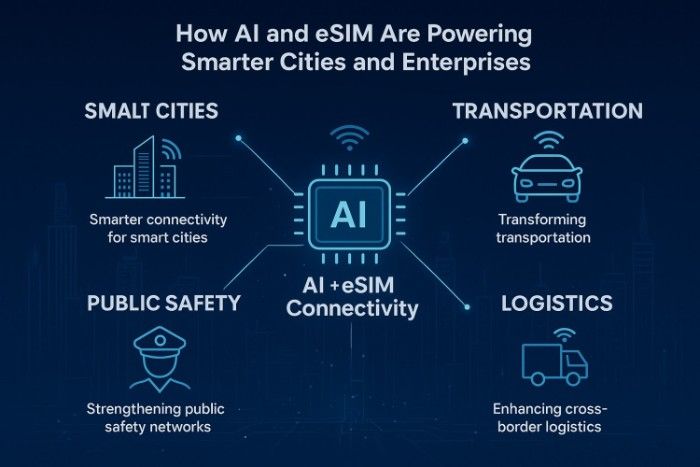Digital infrastructure in North America is undergoing a profound shift, driven by two converging technologies: eSIM connectivity and artificial intelligence. Together, they are redefining how consumers, enterprises, and governments connect devices, manage networks, and scale digital services across both the United States and Canada. In a region where digital adoption is accelerating at an unprecedented rate, the rise of AI-powered eSIM ecosystems marks the beginning of a smarter, more resilient connectivity era.
According to Forbes, even major telecom operators are re-evaluating their models. Recent analysis highlights how eSIM technology is helping mobile network operators reclaim lost roaming revenue and modernize cross-border digital access.
Key Takeaways
- North America is experiencing a digital infrastructure shift with eSIM technology and AI enhancing connectivity.
- eSIM surpasses physical SIMs by facilitating multiple profiles, optimizing network switching, and streamlining cross-border operations.
- AI powers intelligent network management by analyzing conditions in real time, predicting roaming needs, and optimizing IoT deployments.
- The region’s rapid eSIM adoption stems from strong telecom competition, demand for cross-border solutions, and growing IoT integration.
- The future includes iSIM and vSIM, making devices negotiate connectivity intelligently and improving overall digital communication.
Table of Contents
The Evolution from Physical SIM to eSIM
For decades, telecom connectivity relied on physical SIM cards. These removable chips tied users to carriers and hindered the rapid deployment of new services. The introduction of embedded SIM technology (eSIM) eliminates that dependence. An eSIM is built directly into a device’s hardware. It allows multiple profiles to be provisioned or activated digitally without swapping cards or visiting a store.
This shift is especially significant in North America. The high adoption of iPhones, flagship Android devices, industrial IoT sensors, and connected vehicle platforms is driving demand for frictionless connectivity. Devices can now switch networks over the air, making cross-border operations simpler and more efficient. This is especially true between the U.S. and Canada.
As markets adapt, many consumers now search for modern travel and enterprise solutions such as eSIM for Canada and eSIM for USA. This highlights the growing standardization of digital-first connectivity across borders.

AI: The Engine Behind Intelligent Network Management
While eSIM modernizes the hardware layer, AI is transforming the intelligence of the connectivity ecosystem itself. Modern connectivity platforms rely on AI to optimize performance, predict network behavior, detect anomalies, and automate carrier switching.
1. Intelligent Network Selection
AI systems analyze signal quality, latency, data consumption patterns, user location, and device behavior to determine the most optimal network in real time. Instead of relying on static roaming agreements, AI evaluates dozens of parameters simultaneously. It enables devices to prioritize performance, reliability, or cost depending on the use case.
2. Predictive Roaming Across the U.S. and Canada
Cross-border mobility is a daily reality for commuters, logistics operators, and commercial fleets between the two countries. With AI-driven eSIM systems, devices can anticipate when a user is nearing the border. They can automatically preload or activate a relevant carrier profile. This removes the long-standing issue of roaming delays or unexpected costs.
3. AI-Enhanced IoT Management
Industrial IoT deployments, such as smart meters, environmental sensors, supply-chain trackers, and connected vehicles, rely heavily on eSIMs to scale efficiently. AI enhances this ecosystem by:
- Forecasting connectivity issues before they occur
- Optimizing bandwidth usage
- Detecting device failures
- Automating large-scale profile provisioning
- Reducing operational costs for telecom and enterprise platforms
This combination of eSIM and AI is particularly crucial in Canada’s vast rural environments and America’s complex urban networks.
Why North America Is Becoming a Global Leader in eSIM Adoption
The U.S. and Canada are among the fastest-growing regions for eSIM adoption for several reasons:
1. Device Manufacturers Are Going eSIM-Only
Apple’s eSIM-only iPhones in the U.S. set a global precedent. Google, Samsung, and industrial device manufacturers are following, accelerating mainstream adoption throughout North America.
2. Strong Telecom Competition
Competitive markets in both countries allow operators to support digital-first onboarding. They provide instant provisioning and network switching, all ideal for eSIM and AI integration.
3. Large-Scale Cross-Border Demand
Travelers, remote workers, logistics companies, and business commuters frequently search for seamless connectivity options like eSIM for the USA and eSIM for Canada. This further drives demand for interoperable and flexible digital networks.
4. Growing IoT Adoption Across Industries
Utilities, smart agriculture, transportation, and healthcare providers across North America increasingly rely on connected devices. However, these must remain online even in remote or high-mobility environments. eSIM solves this by allowing centralized, automated provisioning at scale.
Impact on Enterprises and Government Infrastructure
1. Smarter Connectivity for Smart Cities
Cities from Seattle to Toronto and Vancouver to Chicago are integrating eSIM-enabled sensors across traffic systems, energy grids, waste management, and emergency networks. AI analyzes sensor data to improve response times, predict infrastructure failures, and allocate resources intelligently.
2. Transforming Transportation
Connected vehicles use eSIM to maintain consistent connectivity across states and provinces. Additionally, AI optimizes routes, monitors vehicle health, and supports autonomous driving systems that require uninterrupted, low-latency communication.
3. Enhancing Cross-Border Logistics
Shipping and freight companies benefit from AI-powered eSIM connectivity. It provides real-time tracking, customs visibility, and automated network switching along North America’s busiest trade routes.
4. Strengthening Public Safety Networks
First responders increasingly rely on eSIM-connected devices powered by AI analytics to manage crowd control, disaster response, and resource deployment. The stability of eSIM networks improves communication during high-demand emergencies.

The Future: Convergence of eSIM, iSIM, and AI-Driven Virtualization
The next phase of North America’s digital infrastructure will include:
- iSIM (integrated SIM) is built directly into the device chipset
- vSIM (virtual SIM) identities managed entirely in the cloud
- AI-driven connectivity orchestration platforms
- Carrier-agnostic mobility layers
In this future model, devices won’t simply connect to networks; they will intelligently negotiate the best connectivity source in real time.
Conclusion
However, the combination of eSIM and AI connectivity is reshaping digital infrastructure across America and Canada, enabling more flexible, secure, and efficient communication systems. From consumer devices to IoT deployments and cross-border industries, North America is rapidly becoming a global model for next-generation connectivity. Platforms like mobile number databases and SIM information tools are increasingly integrated with AI. These tools enhance the management of eSIM ecosystems. Additionally, as AI continues to evolve, its integration into these digital systems will play a defining role in building smarter cities, smarter enterprises, and a more connected digital future across the continent.











